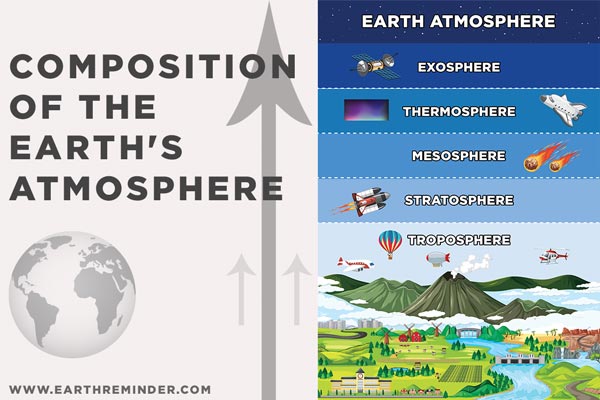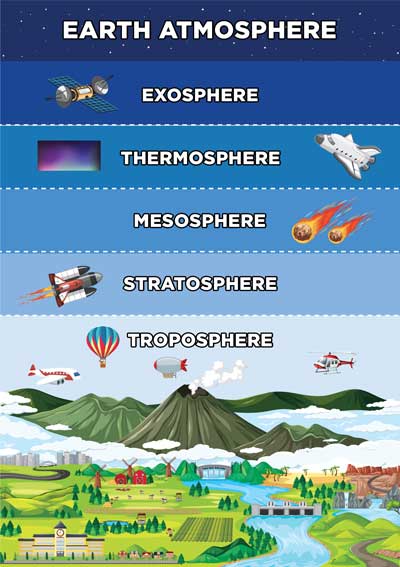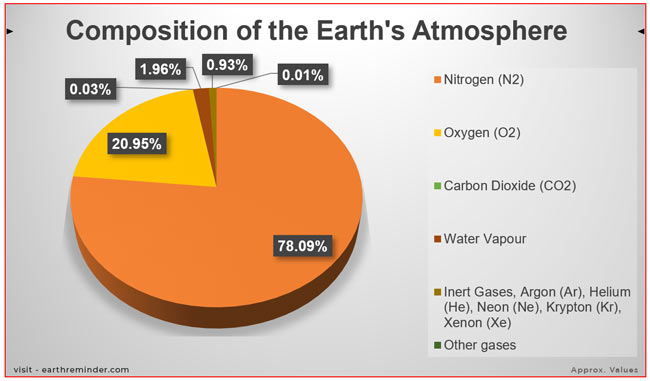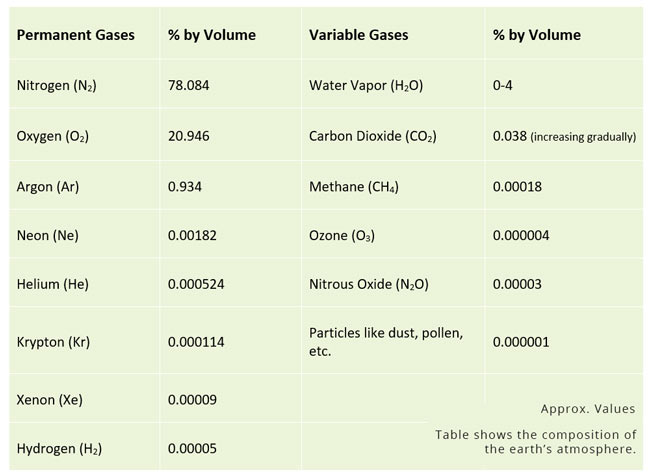Describe the Composition of the Earth’s Atmosphere?
Composition of the earth’s atmosphere: The atmosphere is the most common element of our earth. It includes almost in every chapter of earth science. The weather which influences us every day also is a state of the atmosphere. If the atmosphere didn’t exist, life on earth even couldn’t exist.
The atmosphere is the principal component of our environment. It is a thin structure in comparison with the size of the earth. Several gaseous mixtures take a significant role in forming the earth’s atmosphere.
Earth’s gaseous envelope, i.e., the atmosphere is crucial, yet, do you know why it is essential to understand its composition.
Our atmosphere is a protective agent against several space projectiles such as asteroids and comets. Further, this membrane on earth protects us from harmful sun rays like UV-A and UV-B. The air in the atmosphere is also critical for life as we can’t live without breathing.
So, there’s no doubt that we should study our atmosphere. But can you describe how the earth’s atmosphere formed or from what the composition of it and also what is the structure of it?
Well, today in this article, we will discuss all of these questions. So, read this article entirely for wiping out all of those queries. Let’s begin.
Table of Contents
Earth Atmosphere Composition and Structure:
Majorly our atmosphere is composed of several types of gases. However, its structure is different from its composition. Before understanding other gases making it, let’s know it’s structure.
Structure of the atmosphere:
According to the thermal quality, the earth’s atmosphere is divided into five separate layers, such as:
- Troposphere
- Stratosphere
- Mesosphere
- Thermosphere
- Exosphere
Check the below figure:
These layers of the atmosphere are often called thermal layers due to different temperature gradients. Further, these layers are categorized as homosphere and heterosphere.
So, we can describe the homosphere of our earth’s atmosphere as the portion where the composition of all the gases are uniform. However, the heterosphere is where gases are combined non-uniformly.
Moreover, the first three layers that are the Troposphere, Stratosphere and mesosphere, come under the homosphere. Whereas, the rest two, i.e., Thermosphere and Exosphere, are included under heterosphere.
Troposphere
- The Troposphere is familiar as the lowermost layer of the atmosphere.
- The term troposphere comes from a Greek word that means ‘to turn’.
- Its depth or thickness is usually 8 Km at poles and 18 km at the equator. That means equators are thicker than the polar Troposphere.
- Also, in the equator region, it has a high temperature, and thus air has less density. Less dense air rises up and causes the Troposphere expansion.
- However, in the poles, due to low-temperature air, it becomes more dense and heavy. Therefore, it can’t move high instead sinks down and is a reason for Troposphere contraction.
- Researchers describe that this region has the highest gaseous composition of about 75% of the earth’s atmosphere.
- From the total atmospheric water vapours and aerosols, about 99% present in the Troposphere.
- Therefore, all the weather activities like clouds, precipitation, fog, hail, cyclone, wind are seen here.
- Further, Greenhouse gases, bulk volcanic gases and all the weather systems are felt in this layer.
- The Troposphere is found to be the high-temperature region and the temperature decreases along with increased altitude. This is known as the atmospheric lapse rate.
- The temperature usually decreases by 6.5°c for each kilometre with increased altitude.
- The temperature of the Troposphere remains the warmest near the earth surface.
- At night and during winter, a thermal inversion occurs when the temperature in a thin layer of tropo increases with altitude. This is due to the air near-earth being cooler than above at that time.
- Most life conditions are seen in the Troposphere.
- The outer membrane or boundary of the Troposphere is the tropopause.
- Temperature stops decreasing here and almost remains constant.
- It is too thin and cold that little life exists here and also the clouds present here are of ice crystals.
- The average temperature of the tropopause is about -57°c.
- A few aeroplanes and balloons are seen in this region.
Stratosphere
- The Stratosphere is the second layer of the earth’s atmosphere and has a significant role.
- The layer remains between the Troposphere and mesosphere.
- It starts from tropopause at the height of about 10km (varies in poles to the equator) to 50 km.
- Furthermore, the significance of this region is the presence of an ozone layer.
- The ozone layer helps us to protect against harmful UV radiation which causes skin diseases.
- The temperature fluctuations in this region are just opposite to the Troposphere. That means here temperature increases with an increase in altitude.
- This is due to the presence of an ozone layer.
- The ozone layer absorbs shorter wavelength sun radiations and thus causes more significant agitation due to more kinetic energy of atoms and becomes the reason for temperature increase.
- The lower layer of the Stratosphere has a temperature of – 55°c; however, the upper region has a temperature of – 2°c.
- The highest temperature seen here is 0°c at the stratopause – the boundary of the Stratosphere.
- Also, very rare or no weather activities are seen. Sometimes a special kind of cloud that is Nacrose is observed at the lower part of it.
- Due to such stable atmospheric conditions, it is suitable for most of jet-driven aircraft to move here.
Mesosphere
- It extends from stratopause that is from 50km above sea level to 80-85km.
- The coldest region of the earth’s atmosphere is found in the mesosphere. Here the temperature is about – 85°c.
- Further, the layer under the mesosphere has the coldest air and a significantly less amount of water vapour present in this region.
- Therefore, a few weather conditions like a particular type of cloud that is polar mesospheric noctilucent clouds formed here.
- The best time to see these clouds is at 1-2 hrs after sunrise and at 1-2 hrs before sunset. These are familiar as the highest clouds in the atmosphere.
- Furthermore, lightning-induced discharge or transient luminous events occur in the mesosphere.
- This layer is also known for the destructive region for meteors.
- Jet crafts and balloons can’t reach this layer due to high distance, and also orbital space crafts cannot get to the mesosphere due to very low height.
- Here the outermost region is known as mesopause.
Thermosphere
- The extent or height of the Thermosphere varies due to increased solar activities. It usually remains between the 500-1000km height from sea level.
- Thermopause is a layer that separates the Thermosphere from the Exosphere.
- Besides, this atmospheric membrane hampers some cosmic rays, i.e., X-rays, Gamma rays, and some UV-rays.
- Here temperature may reach 1,500°C, yet, due to the least number of atoms, the heat energy remains low.
- Some isolated gas molecules after breaking down form ions due to the interaction with solar radiation with O2 and N2 captures electrons from them.
- These ions form a separate layer between 80 to 400km thickness, and this layer is known as the ionosphere.
- Auroras – a type of visual effect that looks spectacular, often familiar as northern and southern lights are also seen in this sphere.
- These lights are formed due to the reaction of electrons and protons from the sun with the ionosphere.
- Hydrogen and helium ions are present in the outer layer of the Thermosphere.
- Also, the International space station occurs in this layer.
Exosphere
- The exosphere is the outermost layer of the atmosphere that directly connects with space.
- It started from thermopause and blended with the solar wind.
- The exosphere of the earth’s atmosphere extends up to 1600km from sea level.
- Furthermore, a few types of gaseous components are present here.
- Atoms and molecules present in this region move extremely fast.
- Besides, a high temperature is observed here because of the direct contact with solar radiations.
- A very thin layer of air is present in the Exosphere, and thus satellites and spacecraft orbiting the earth in this region have little resistance.
- Scientists often observe Auroras in the lower part of this layer.
How can we describe the composition of the earth’s atmosphere?
We breathe oxygen and plants take CO2 from us for photosynthesis. But besides these two gases, there are several other components that create our atmosphere.
However, only two gases create the bulk of the atmosphere as they are present about 99% and the rest of the different gases are present about only 1%. These two gases are nitrogen and oxygen.
Broadly we can classify all the components of the earth’s atmosphere into two parts:
Permanent Gases
Permanent gases are those whose quantity remains the same in every part of our earth. For example, the concentration of oxygen is ~21%. So, if we collect some air in Asia and some air in Africa and then measure the components in both, then we will get the same quantity of oxygen in both continents.
We can memorize nitrogen, oxygen, hydrogen, and inert gases like argon, neon, helium, krypton and xenon as permanent gases.
Variable Gases
However, variable gases are those whose quantity or percentage by Volume differ with places and regions. For instance, the concentration of water vapour in the equator and polar region varies from time to time and season to season. Similarly, greenhouse gases like methane and carbon dioxide and much more also varies from region to region.
Some variable gases include water vapour, carbon dioxide, methane, ozone, nitrous oxide and also atmospheric dust, pollen and other minute particles.
The following table shows the composition of the earth’s atmosphere.
Conclusion:
Gravity keeps the atmosphere around the earth, which can further pull away due to the presence of the vacuum. Our atmosphere obeys all laws of thermodynamics and maintains equilibrium.
There are lots of complexities associated with that gaseous membrane on earth. However, understanding the composition and structure of the earth’s atmosphere can make it easier for us to grasp effectively.
Here we describe different layers or structures of the earth’s atmosphere as well as its composition. If you have more queries, comment down below and follow us for similar informative contents.



